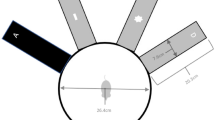Abstract
Changes in odor preferences with age were assessed in house mice inhabiting a series of eight 0.1-ha outdoor enclosures. The most recent capture in a live trap was assumed to provide the predominant odor in that trap for one week. Data were analyzed for two separate years for females and males and for three age classes within each sex. Initial analyses confirmed the use of the odor baiting technique; significantly more mice than expected entered traps that had captured another mouse in the previous week relative to traps that had not caught a mouse for at least a week. For female mice two predictions were tested. (1) Young female mice avoid traps with odors from adult males. The findings support this prediction. (2) As they mature, female mice will shift their odor preference and enter significantly more traps odorized by adult males. The findings also support this prediction. Two predictions were tested for male mice. (3) Young male mice will avoid odors from adult males. The data do not support this prediction. (4) As they mature, males will shift their preference and enter more traps odorized by female mice. Some, but not all of the data support this hypothesis.
Similar content being viewed by others
REFERENCES
Bower, J. M., and Alexander, B. K. 1967. Mice: Individual recognition by olfactory cues. Science 158:1208-1210.
Bronson, F. H. 1979. The reproductive ecology of the house mouse. Q. Rev. Biol. 54:265-299.
Bronson, F. H. 1983. Chemical communication in house mice and deer mice—functional roles in reproduction in wild populations, pp. 198-238, in J. G. Eisenberg and D. G. Kleiman (eds.). Advances in the Study of Mammalian Behavior. American Society of Mammalogists, Speical Publication #7.
Brown, L. E. 1966. Home range and movements of small mammals. Symp. Zool. Soc. London 18:111-142.
Coppola, D. M., and O'Connell, R. J. 1988. Behavioral responses of peripubertal female mice towards puberty-accelerating and puberty-delaying chemical signals. Chem. Senses 13:407-424.
Cox, T. P. 1984. Ethological isolation between local populations of house mice (Mus musculus) based on olfaction. Anim. Behav. 32:1068-1077.
Crowcroft, P. 1966. Mice All Over, G. T. Foulis and Co., London.
Crowcroft, P., and Rowe, F. P. 1963. Social organization and territorial behaviour in the wild house mouse (Mus musculus L.) Proc. Zool. Soc. London 140:517-531.
Delong, K. T. 1967. Population ecology of feral house mice. Ecology 48:611-634.
Drickamer, L. C. 1977. Delay of sexual maturation in female house mice by exposure to grouped females or urine from grouped females. J. Reprod. Fertil. 51:77-81.
Drickamer, L. C. 1986. Puberty-influencing chemosignals in mice: Ecological and evolutionary considerations, pp. 441-455, in D. Duvall, D. Müller-Schwarze, and R. M. Silverstein (eds.). Chemical Signals in Vertebrates IV. Plenum Press, New York.
Drickamer, L. C. 1988. Long-term effects of accelerated or delayed sexual maturation on reproductive output in wild female house mice (Mus musculus). J. Reprod. Fertil. 83:439-445.
Drickamer, L. C. 1989. Odor preferences of wild stock female house mice (Mus domesticus) tested at three ages using urine and other cues from conspecific males and females. J. Chem. Ecol. 15:1971-1987.
Drickamer, L. C. 1992. Behavioral selection of odor cues by young female mice affects age of puberty. Dev. Psychobiol. 25:461-470.
Drickamer, L. C. 1995. Odors in traps: Does most recent occupant influence capture rates for house mice? J. Chem. Ecol. 21:541-555.
Drickamer, L. C. 1997. Responses to odors of dominant and subordinate house mice (Mus domesticus) in live traps and responses to odors in live traps by dominant and subordinate males. J. Chem. Ecol. 23:2493-2499.
Drickamer, L. C., and Mikesic, D. G. 1990. Urinary chemosignals, reproduction, and population size for house mice (Mus domesticus) living in field enclosures. J. Chem. Ecol. 16:2955-2968.
Hurst, J. L. 1990a. Urine marking in populations of wild house mice, Mus domesticus Rutty. I. Communication between males. Anim. Behav. 40:209-222.
Hurst, J. L. 1990b. Urine marking in populations of wild house mice, Mus domesticus Rutty. II. Communication between females. Anim. Behav. 40:223-232.
Hurst, J. L. 1990c. Urine marking in populations of wild house mice, Mus domesticus Rutty. III. Communication between the sexes. Anim. Behav. 40:233-243.
Hurst, J. L., and Nevison, C. M. 1994. Do female house mice, Mus domesticus, regulate their exposure to reproductive priming pheromones? Anim. Behav. 48:945-959.
Kareem, A. M., and Barnard, C. J. 1986. King recognition in mice: Age, sex and parental effects. Anim. Behav. 34:1814-1824.
Mikesic, D. G., and Drickamer, L. C. 1992. Factors affecting home-range size in house mice (Mus musculus domesticus) living in outdoor enclosures. Am. Midl. Nat. 127:31-40.
Mossman, C. A., and Drickamer, L. C. 1996. Odor preferences of female house mice (Mus domesticus) in seminatural enclosures. J. Comp. Psychol. 110:131-138.
Solomon, N. G., and Rumbaugh, T. 1997. Odor preferences of weanling and mature male and female pine voles. J. Chem. Ecol. 23:2133-2143.
Vandenbergh, J. G. 1969. Male odor accelerates female sexual maturation in mice. Endocrinology 84:658-660.
Vandenbergh, J. G., and Coppola, D. M. 1986. The physiology and ecology of puberty modulation by primer pheromones. Adv. Stud. Behav. 16:71-108.
Winn, B. E., and Vestal, B. M. 1986. Kin recognition and choice of males by wild female house mice (Mus musculus). J. Comp. Psychol. 100:72-75.
Zar, J. H. Biostatistical Analyses, 3rd ed. Prentice-Hall, Upper Saddle River, NJ. 1996.
Author information
Authors and Affiliations
Rights and permissions
About this article
Cite this article
Drickamer, L.C., Brown, P.L. Age-Related Changes in Odor Preferences by House Mice Living in Semi Natural Enclosures. J Chem Ecol 24, 1745–1756 (1998). https://doi.org/10.1023/A:1022395130489
Issue Date:
DOI: https://doi.org/10.1023/A:1022395130489




